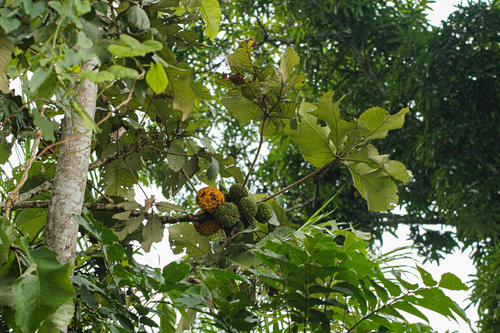Myrianthus arboreus

|
|
Myrianthus arboreus Common Names: Giant yellow mulberry, Monkey-fruit,
Corkwood Scientific
Classification Kingdom: Plantae Clade: Tracheophytes Clade: Angiosperms Clade: Eudicots Clade: Rosids Order: Rosales Family: Urticaceae Genus: Myrianthus Species: M. arboreus Authority: P.
Beauv. Synonyms: Morphological Description · Height: 3–12 m (occasionally up to 20 m); dioecious shrub or small
tree. · Bark: Grey-green, smooth to slightly rough; exudes sticky white
latex. · Leaves: Palmately compound with 3–7 lanceolate leaflets (20–65 cm
long); serrate margins and hairy stipules (3–5 cm). · Flowers: Male flowers in dense panicles (5–15 cm); female flowers in
compact heads (2–5 cm). · Fruits: Yellow to orange-red drupes (1–2 cm), sweet pulp with hard
endocarp (~1.7 cm long). Distribution and Habitat · Range: Native to tropical Africa (Guinea → South Sudan → Angola →
Tanzania). · Elevation: 0–1,800 m above sea level. · Climate: 1,400–3,000 mm rainfall annually; temperature 22–28°C. · Soil: Prefers clayey to loamy soils (pH 4.5–6.5). · Ecology: Thrives in secondary forests, riverbanks, and disturbed
areas; pioneer species aiding forest regeneration. Ethnopharmacology · Antidiabetic: Ethanol root bark extracts (50–100 mg/kg) reduce blood
glucose by 30–40% in diabetic rats through α-amylase inhibition and improved
glucose uptake (Harley et al., 2020). · Anti-inflammatory: Methanol leaf extract reduced TNF-α and
IL-6 levels in obese mice, enhancing insulin sensitivity (Tijani RO et al.,
2021). · Reproductive Health: Leaf aqueous extract improved fertility
and reduced polycystic ovarian symptoms in letrozole-induced rats (Mvondo et
al., 2020). · Wound Healing: Leaf and bark extracts promoted 30% faster wound closure and
inhibited S. aureus and E. coli (Agyare et al., 2014). · Antimicrobial: Demonstrated MIC values of 50–100 μg/mL against pathogenic
bacteria (Agyare et al., 2014). · Phytochemistry: Contains alkaloids, flavonoids, tannins,
saponins, phenols, triterpenoids, quercetin, and oleanolic acid (García-Pérez
et al., 2023). ⚠ Toxicity Profile: Generally safe (LD₅₀ > 5,000 mg/kg in rats). Prolonged
high-dose use may cause mild leukocyte changes; caution advised in pregnancy
due to emeto-purgative fruit properties (Awounfack et al., 2016). Additional Uses · Culinary: Leaves used in soups; fruits eaten fresh or fermented (Bobuya,
P et al., 2022). · Economic: Fruits and leaves sold in markets; wood used for timber and
fuel (World Agroforestry Centre, n.d.). · Industrial: Wood ash for soap; leaf extracts repel termites
(García-Pérez et al., 2023). · Ecological: Improves soil organic matter; supports pollinators and
wildlife (Tchoundjeu & Atangana, 2006). · Cultural: Used in fertility rituals and traditional ceremonies in West
Africa (Kew Science, n.d.). References
External Links
More Pictures
|
|
| Compounds of Myrianthus arboreus | |
| References |